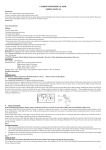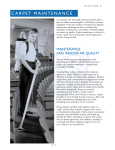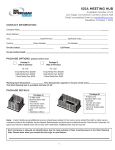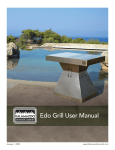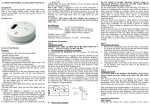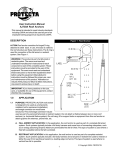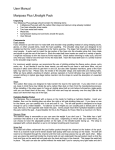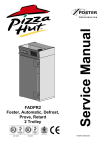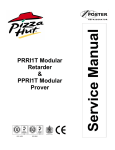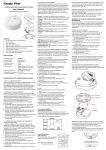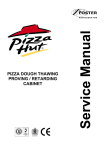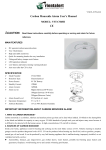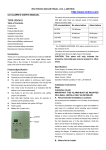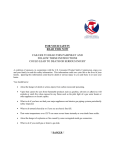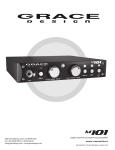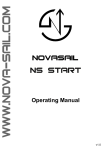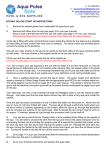Download Satellit e Satellit e - Pdfstream.manualsonline.com
Transcript
Satel lite Satellit Owner Owner’s Manual Mountain Hard w e a r 4911 Central Av e n u e Richmond, CA 94804 510-558-3000 FAX 510-559-6709 © 1999 All rights reserved. Printed on recycled paper. PLEASE READ THIS MANUAL. IT CONTAINS IMPORTANT INFORMATION ABOUT YOUR TENT. hank you for choosing a Mountain Hardwear tent. We take pride in making lightweight, durable shelters for outdoor enthusiasts. Please take the time to read this user manual and “test pitch” your new tent before taking it into the wilderness. Satellite SELECTING A SITE Choose a site that is level, clear of sharp stones and other debris, is sheltered from the wind, and will drain when it rains. You may wish to face your tent south or east to catch the morning sun. Do not pitch your tent under trees, in water drainages, or on ridge tops. ASSEMBLING THE POLES Unfold the tent body and lay it flat on the ground with the door unzipped. Unfold the shock-corded tent poles so they spring together gently. Make sure that each insert from each pole section is fully engaged into the next pole section, otherwise you will damage the tubing (Figure 1). insert Figure 1 PITCHING THE TENT 1. Spread the tent out evenly (Figure 2). In the illustration, the dotted lines represent the five long purple poles and the dashed lines represent the five shorter black poles. Adjust all grommet tabs to the same length. Figure 2 WARNING !!! For your safety, please read and understand the warning on page 14. If you do not understand any part of the warning call Mountain Hardwear at 510.559.6700 before using the tent. purple pole PARTS LIST ◆ Owner’s Manual ◆ Tent body ◆ Tent poles (5 long purple poles, 5 shorter black poles) ◆ Tent pegs (20) ◆ Window covers (3) ◆ Line tighteners (20) ◆ 200 ft. spool of cord ◆ Tent fly ◆ Pole sack ◆ Tent peg sack ◆ Tent stuff sack ◆ Cord (20 pieces) ◆ Seam sealer (6 tubes) ◆ Pole repair sleeves (3) black pole 2. All grommet tabs are color-coded. Attach all five purple poles to the purple grommet tabs. Make sure to guide the poles along the seam lines (Figure 3). Attach all clips along the seam lines to the poles. Attach double clips at all ten pole intersections as shown in Figure 3a . 3.Attach all five black poles (Figure 4) to the black grommet tabs. Attach all corresponding clips as described in Step 2. Figure 4 Figure 3 black poles Figure 3a 4. Stake out all ten webbing loops along the tent perimeter (Figure 5). 5. To attach the flysheet, drape the fly over the tent (Figure 6). Figure 6 Figure 5 Fly 6. Attach all clips along the fly perimeter to the poles on the tent body (Figure 7). Figure 7 Fly Tent body 7. There are three clear UVX widows on the Satellite tent body. The Satellite comes with three window covers which can be attached either inside the tent (as shown in Figure 8) or outside the tent over the windows. Place the widow covers on the outside to protect the windows from direct sun. Place them on the inside of the tent if you wish to use the storage pockets sewn to the window covers. Figure 8 HOW TO CARE FOR YOUR TENT ON THE TRAIL Stormproofing Your Tent Even though most of our tents are free-standing, we recommend you always stake out your tent to prevent it from flying away in a gust of wind. Secure all stake-out webbing loops located on the perimeter of the tent. Attach all external guy lines to tent pole intersections (Figure 10). Figure 10 Pole intersection Guy line Pocket 7. The Satellite is a floorless tent, designed for use in snow and rugged terrain. An optional floor/footprint can be purchased to create a removable waterproof floor. Attach this floor by clipping the snap hooks which are sewn to it to the O-rings located on the inside tent perimeter (Figure 9). Use your internal guy system for extreme weather conditions and high winds. The internal guy system consists of pieces of cord (96” long) and line tighteners (Figure 11). As the wind increases, increase the tension by tightening the line tighteners. Figure 9 Tent body Optional floor/ footprint Figure 11 Ultraviolet (UV) Light Zippers Ultraviolet light degrades lightweight tent fabric (and almost any synthetic material). UV light will cause the fabric to fade, lose strength, and eventually disintegrate. The canopy of the Satellite consists of an UV-resistant, waterproof, titanium dioxide membrane laminated to a 40-denier polyester ripstop fabric. While this titanium dioxide membrane is practically UV-proof, the polyester fabric is not. The best way to prolong the life of any tent is to keep it out of the sun as much as possible. Pitch the tent in a shady spot whenever possible. By striking (taking the tent down) in the morning and repitching the tent late in the day, you will add to any tent’s longevity. One of the keys to zipper longevity is to keep them away from sand and grit. When pitching your tent, be careful to keep the door and window zippers out of the dirt. Never step on the zipper. Keep zippers clean by washing them (at home) with a garden hose and pressure nozzle. Food Storage Never store food in your tent. Animals will often tear or bite their own entrance into a tent to get at your food. Most zipper failures result from wear to the coating on the inside of the zipper slider (the metal toggle). Once that coating wears off, the metal abrades rapidly, and the zipper slider no longer joins the continuous plastic coils securely. The plastic coils then tend to separate behind the zipper slider. You can replace a worn out zipper slider with our patented Zipper Repair Clamp. The Zipper Repair Clamp (pictured below) is available from your local Mountain Hardwear dealer. Pole Care When assembling the poles, never allow the pole sections to snap against each other. Always make sure that all pole sections are fully engaged before bending. Keep the poles clean and free of silt, sand, and salt, taking special care with the tips as they are not anodized and can corrode. When disassembling your poles, always start from the center, then work your way to the tips. This allows the elastic cord to be evenly stretched, an important matter when the poles are stored disassembled for a long period of time. FIELD REPAIRS Tears and Other Damage Small holes and tears can be repaired in the field using either a needle and thread, adhesive repair tape, or liquid urethane (Mcnett™ Seam Grip). Field repairs do not void the warranty of your tent. Poles CARING FOR YOUR TENT AT HOME If you break a tent pole you can repair the break temporarily by splinting the pole with a short aluminum sleeve (called a repair sleeve—three such sleeves are provided with the Satellite). The aluminum repair sleeve is fitted over the broken pole section and taped (or wedged) into place. Ski pole repair sleeves, tent stakes and even branches can be used to splint broken tent tubes. Never pack or store your tent if it is dirty and/or damp. If you do so, mildew can form and ruin the waterproof coating on your tent. Mildew will cause your tent to smell and can eventually delaminate and damage the polyurethane coating which will cause your tent to leak. There is no cure for mildew damage. Prolonged moisture on the polyurethane coating (storing the tent wet for more than a few days) can cause hydrolysis. This will soften the coating and cause the coated fabric to become sticky and bond to itself. Mildew damage and hydrolysis are not covered under our Lifetime Warranty. Seam Sealing Your Tent If your tent will be subject to prolonged rainfall, all doubleneedle seams on the tent body and the floor perimeter seams must be sealed. Do not seam seal the zippers. Pitch the tent in a well ventilated area (preferably out of doors and in the shade). Make sure the tent is clean, dry, and taut. Stake out the tent floor. Never seam seal in cold, damp (humid) environments. Seal the coated (dull) side of the fabric whenever possible. On the Satellite, the coated side is on the outside of the tent. Seam sealer does not adhere as well to the uncoated side because the water repellent finish is applied to that side. Apply several thin coats instead of one thick coat. Work the seam sealer into the seams and on top of the Seal over double-needle stitching by applystitching. ing pressure and brushing the liquid back and forth. Seam seal all points where webbing is sewn Seal into or on a seam. Work the under fold. sealer into and around these coated side of fabric attachment points using the techniques described above. The seam along the tent floor perimeter where webbing is attached should also receive extra attention. Follow the drying instructions on the seam sealant tube carefully to prevent damaging your tent. HOW MUCH DOES YOUR TENT WEIGH? The weight of a tent is one of the most important factors used by consumers when making purchasing decisions. In the past, tent manufactures have independently determined which components they included in their publicized weights. The Tent Manufacturers Association (T.M.A.), under the Outdoor Recreation Coalition of America (O.R.C.A.) umbrella, has set voluntary guidelines for how tent manufacturers determine and report the weights of their tents. Under the T.M.A. guidelines, there are two weights manufacturers can report: the Minimum Weight and the Packaged Weight. Minimum Weight: The Minimum Weight is the total weight of the tent body, flysheet, and poles only; it is the weight of the bare essentials. This is the figure most often used for comparative purposes when purchasing a tent. Packaged Weight (Also known as Trail Weight): The Packaged Weight includes everything that comes with the tent when the tent is purchased (less any shipping container): tent body, flysheet, poles, tent stuff sack, pole sack, peg sack, pegs, cord, line tightners, user manual, repair items and any other items included by the manufacturer other than shipping materials. Cleaning Your Tent LOW IMPACT CAMPING Never machine wash or machine dry your tent. For localized cleaning, use a sponge with warm water. When cleaning the entire tent, wash in a tub (bathtub) of cold water. Never use hot water, bleach, dish-washing liquid, pre-soaking solutions, or spot removers. If you use soap, always use a non-detergent soap. Dry your tent by pitching it in the shade or by line drying only. Never machine dry your tent. Camp away from streams, lakes and trails. Use biodegradable soaps sparingly, 200 feet or more from water. Pack out what you bring in. Please call 800.332.4100 for more information on LEAVE NO TRACE camping. TENT ACCESSORIES Mountain Hardwear offers the following tent accessories: ◆ The Gear Loft—a clip-in “attic” for stowing gear inside the tent ◆ Easton tent pegs—long-lasting, durable pegs made from 7075 E9 aluminum ◆ The Snow and Sand Anchor—a bombproof way to guy-out your tent in snow or sand Storing Your Tent Store your tent in a cool, dry environment. Pack the tent loosely, and, if possible, leave the shock-corded poles completely or partially assembled. ◆ V-Pegs These accessories are available at your Mountain Hardwear dealer. MOUNTAIN HARDWEAR LIFETIME WARRANTY Mountain Hardwear guarantees that the materials and workmanship in every product we make will stand up to the use for which it was designed. This warranty does not cover damages caused by improper care, accidents or natural breakdown of materials over extended time and use. All products should be returned to us for evaluation and will be repaired or replaced at our discretion. Damages due to accident or improper care will be repaired at a reasonable rate. REPAIRS All items covered under our warranty will be repaired or replaced (at our discretion) at no charge. We can provide cost estimates for repairing damaged items not covered by our warranty. California State Law requires that all items which are to be repaired must be clean. We do not have the facilities to wash tents. Soiled tents will be returned to the owner for cleaning before the item can be repaired. The Mountain Hardwear Warranty Department can be reached at: Mountain Hard w e a r 4911 Central Av e n u e Richmond, CA 94804 510-558-3000 FAX 510-559-6709 W A R NING!!! P LE ASE R E AD! FIRE: All Mountain Hardwear tents are made of flameretardant materials, but most nylon and polyester fabric will melt or burn when exposed to high heat or an open flame. Never place your stove, hibachi, campfire, or other heat source in or near your tent. We recommend that you always position your tent upwind of a camp fire. This will reduce the chances of having a flying ember land on your tent. Never use a candle as a light source inside your tent. Do not cook with, light, or refuel a stove (or any other heat source) inside your tent or in your vestibule! Asphyxiation and serous injury are possible! Stoves, hibachis, lanterns and heaters can malfunction (operator error is also possible) and can start a fire that will spread too rapidly for occupants to escape a tent. Using combustible materials and/or petroleum-based fuels can increase the carbon dioxide levels within a tent enough to cause asphyxiation to the occupants. Maintain adequate ventilation inside your tent at all times. Never seal your tent up completely. Always leave a small part of a window open. Never allow your tent to become buried in snow past the bottom of the flysheet since this may allow the carbon dioxide and carbon monoxide levels inside the tent to become dangerously high. Campsite selection: Consider the possibility of falling rocks or tree limbs, lightning strikes, flash floods, avalanches, strong winds, and other objective hazards when choosing a campsite. Properly stake and guy out your tent at all times. Lightweight tents are very strong for their weight and can withstand severe weather when properly staked out and guyed out. Always use the proper tent stakes to anchor your tent and guylines to the ground. Use the internal guy system (included with all four-season tents) during severe weather. You may wish to purchase more and/or different tent stakes and nylon cord, depending on when and where you intend to use your tent. It is impossible for Mountain Hardwear to include anchors for every possible environmental condition. IF YOU DO NOT UNDERSTAND ANY PART OF THIS WARNING CALL MOUNTAIN HARDWEAR AT 510-558-3000 BEFORE USING THE TENT.










